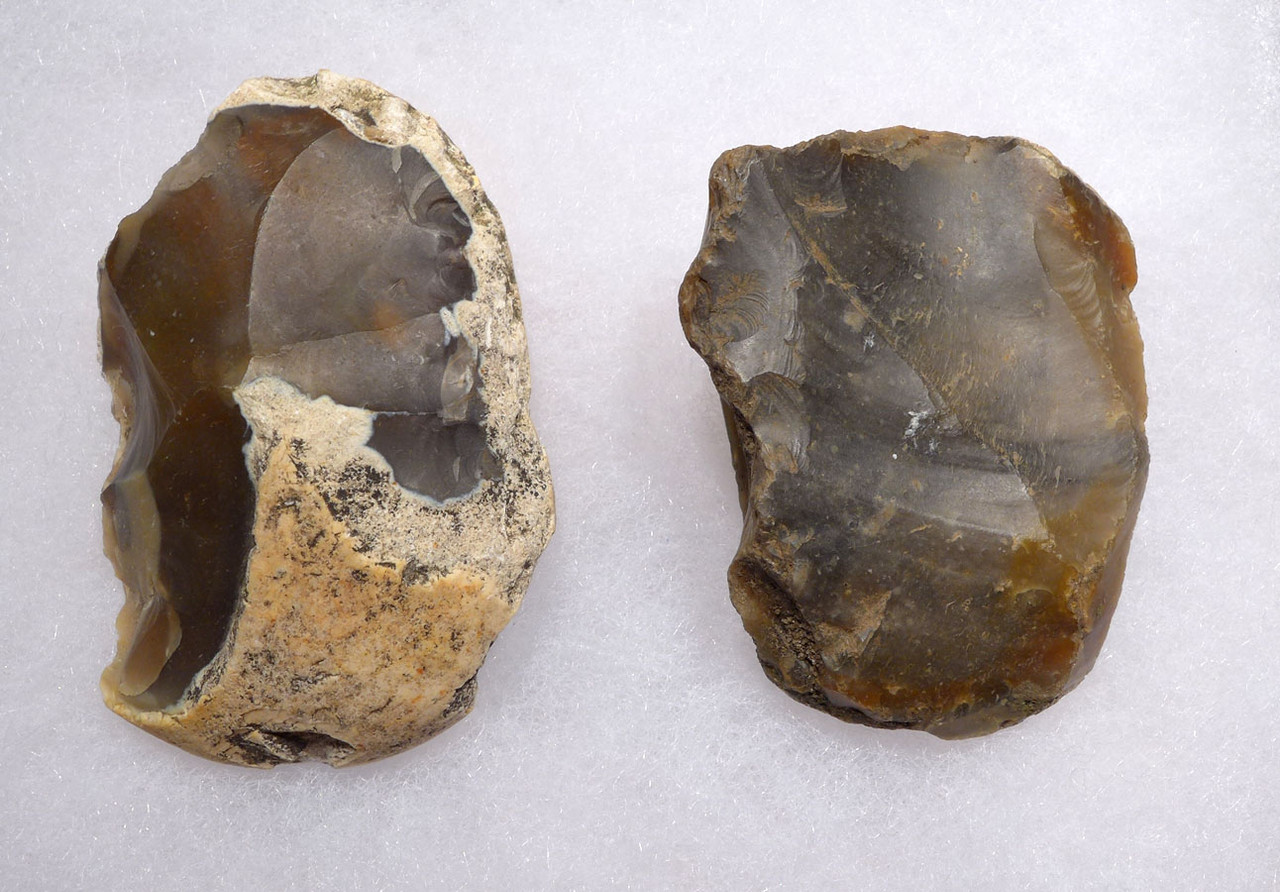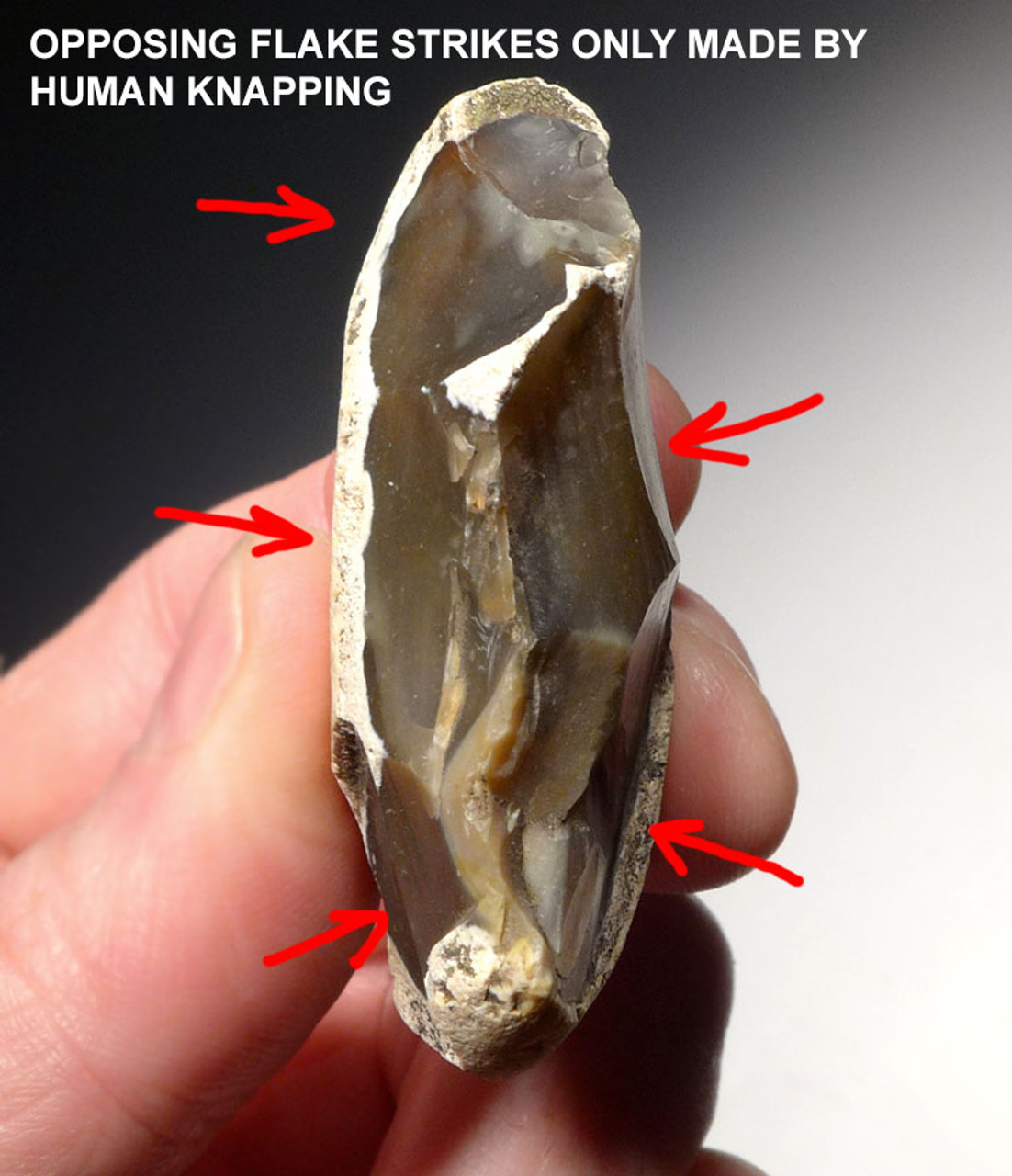Product Description
No artifact could be more important or impressive than the first stone tool of primitive humans. This particular tool set includes two flint pebble tool scrapers manufactured in the Oldowan tradition. These stone tools date back to the VERY FIRST humans of Europe! These magnificent pebble tools were fashioned by Homo erectus over half a million years ago, made from a flint pebble. They represent evidence of some of the oldest human occupation of western Europe and the UK.
These pebble tools were found in England near the Coastal Norfolk town of Runton. The area was once part of a prehistoric river estuary system that flowed into the North Sea and included the Thames, fed by an extinct river from the Midlands called the Bytham. The Bytham River was one of the great Pleistocene rivers of central and eastern England until it was destroyed by the advancing ice sheets of the Anglian Glaciation around 450,000 years ago. Its estuary system included Worcestershire, Warwickshire, Oxfordshire and Derbyshire, and it flowed eastward across East Anglia to the North Sea. It was formed prior to the Anglian ice advance roughly 450,000 years ago, originating around modern day Reading, and flowing northeast to a delta somewhere between modern day Happisburgh and Norton Subcourse in East Anglia. During this time in prehistory, southern England was connected to France by a land bridge and the rivers, including the Rhine, flowed north into a lake formed at the edge of the ice sheet. This region is also famous for the discovery of the remains of a Steppe Mammoth dated to 600,000 years. The fossil discovery in West Runton marks the oldest mammoth skeleton to have been found in the UK and the most complete specimen of the species to have been found in the world.
Classic textbook features abound in both superb examples. Several strategic flakes were removed by opposing strikes, to create a sharp cutting edge. There is even a flaked area on the back side which was made to secure your index finger as you press down on the tool while in use. Much of the original pebble outer cortex remains, providing a naturally ergonomic grip on the tool versus a sharp flake. A heavy colorful patina and intact mineral deposits deep in flaked micro-crevices, provide proof of the age and authenticity and are features not seen in modern forgeries. Workmanship is excellent affording a well-thought out design and functional grip when held.
HISTORY
The majority of the evidence for Lower and Middle Paleolithic occupation in East Anglia survives as redeposited flakes and tools recovered from river gravel deposits made by the ancestral Thames and Bytham River systems. The area where this stone tool was found was once part of a prehistoric river estuary system that flowed into the North Sea and included the Thames, fed by an extinct river from the Midlands called the Bytham. The Bytham River was one of the great Pleistocene rivers of central and eastern England until it was destroyed by the advancing ice sheets of the Anglian Glaciation around 450,000 years ago. Its estuary system included Worcestershire, Warwickshire, Oxfordshire and Derbyshire, and it flowed eastward across East Anglia to the North Sea. It was formed prior to the Anglian ice advance roughly 450,000 years ago, originating around modern day Reading, and flowing northeast to a delta somewhere between modern day Happisburgh and Norton Subcourse in East Anglia. During this time in prehistory, southern England was connected to France by a land bridge and the rivers, including the Rhine, flowed north into a lake formed at the edge of the ice sheet.
Evidence of prehistoric human occupation in the area was recently recorded by the amazing discovery of footprints called the The Happisburgh footprints. These were a set of fossilized hominid footprints that date to the early Pleistocene, over 800,000 years ago. They were discovered in May 2013 in a newly uncovered sediment layer of the Cromer Forest Bed on a beach at Happisburgh in Norfolk, England, and carefully photographed in 3D before being destroyed by the tide shortly afterwards. Results of research on the footprints were announced on 7 February 2014 and identified them as the oldest known hominid footprints outside Africa. Approximately fifty footprints were found in an area measuring nearly 40 square meters (430 sq ft). Twelve were largely complete and two showed details of toes. The footprints of approximately five individuals have been identified, including adults and children. The Happisburgh footprints mark the first time evidence of early humans from 1,000,000 years ago has been found so far north. Paleontologists had believed that hominins of the period required a much warmer climate, but the inhabitants of prehistoric Happisburgh had adapted to the cold, suggesting that they had developed advanced methods of hunting, clothing, sheltering and warming much earlier than previously thought.
This region is also famous for the discovery of the remains of a Steppe Mammoth dated to 600,000 years. The fossil discovery in West Runton marks the oldest mammoth skeleton to have been found in the UK and the most complete specimen of the species to have been found in the world.
WARNING: There are a host of these "tools" for sale on Ebay and many online sellers' websites providing less information and understanding of Lower Paleolithic specimens. Many of these sources offer nothing more than damaged ancient river cobbles caused by environmental action (glacial disturbance, frost damage, etc.) or modern made fakes. Every broken cobblestone found is NOT a human-created Paleolithic tool! The determination of what is man-made and what is an ordinary broken river rock requires a very high level of understanding Paleolithic tool manufacture and technique as well as the experience to be able to differentiate the two and authenticate a genuine stone tool from this culture. Know your source and only deal with well-informed sellers who can help you understand the difference.
 US DOLLAR
US DOLLAR
 EURO
EURO
 AUSTRALIAN DOLLAR
AUSTRALIAN DOLLAR
 CANADIAN DOLLAR
CANADIAN DOLLAR
 POUND STERLING
POUND STERLING




















